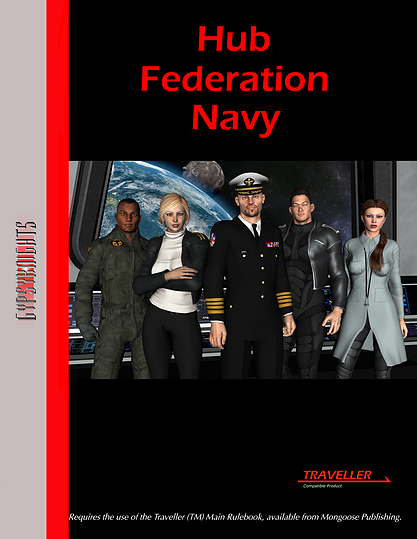Hub Federation Navy
This review originally appeared on rpg-resource.org.uk in November 2014 and is reprinted here and in the February/March 2015 issue with permission.
 Hub
Federation Navy. Michael Johnson.
Hub
Federation Navy. Michael Johnson.
Gypsy Knights Games http://www.gypsyknights.com
96pp., softcover and PDF
US$6.99(P)19.99(S,S&P)/UKú4.54(P)12.99(S,S&P)
At its simplest level, this is a sourcebook for the Hub Federation Navy and of great use if you are running a game in Gypsy Knights Games’s alternate Traveller universe based around the Clement Sector. If so, you will find several other of their books invaluable, including The Hub Federation and Clement Sector as well as, of course, the core Traveller rules from Mongoose. However, this would be a good basis for creating the naval forces for any pocket empire of your own devising, whereas the extensive naval career tables could enhance any game in which naval forces (or characters with naval backgrounds) are involved.
The first part of the book details the history and current organisation of the Hub Federation Navy—copious detail even down to their uniforms and rank badges! The Hub Federation Navy was formed after the wormhole back to Earth collapsed out of British Royal Navy and German Navy fleets that were in the Hub sub-sector at the time. (A US fleet was also present but declined the invitation to join the alliance.) Most things are now handled bilingually, with a deliberate attempt to combine the best of both naval traditions, although the ‘official’ language of the Navy is German. A new uniform was designed, in space black rather than navy blue, which includes features of both British and German uniforms. Descriptions are given of dress/service uniforms, working dress and combat dress and even officer’s evening dress (mess dress). There are even a couple of illustrations and a rank chart to help you visualise the fine display. Female personnel dress exactly like males except that they are permitted skirts on shore billets (but not aboard ship).
The next section is about Characters and deals with those characters who would like a naval background. Whilst they can use the career paths presented later on, it is to be remembered (if you are playing this alternate setting as is) that the Hub Federation Navy is only some eleven years old so anyone wishing to have served more than three terms will have started in another navy—probably the German or British one. There is a Career Companion supplement which is ideally suited to dealing with characters of specific national navies. There are details of the Hub Federation Naval Academy and recruit training, as well as of progression thereafter through a naval career. This section ends with notes on the medals and other awards available to naval personnel… no pictures, alas, but good details of terms of award.
This is followed by the various career paths offered to members of the navy, which will empower detailed character generation and backstories… and could be used as an ongoing career track if you decide to run a game around serving members of the Hub Federation Navy rather than retired ones who are now off doing something else! There are loads of options available, not just the regular engineering, flight, support, etc., but naval intelligence, a ‘command’ track for bridge crew and possibly most interesting, ‘senior command’ and ‘higher command’ options for those seeking to command a naval vessel or even aiming for Admiral’s rank.
Finally, Appendices detail the different classes of vessel in the navy and current fleet organisation complete with example squadrons and the present list of ships.
Overall, a spectacular resource if you are running a navally-oriented game in the Clement Sector or if you have a character who has served in the Hub Federation Navy; and of some use—perhaps with adaptations—if your game is elsewhere but you like the amount of detail about naval careers in particular.
 Freelance
Traveller
Freelance
Traveller